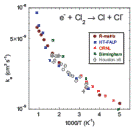Department of Physics and Astronomy: Publications and Other Research
Date of this Version
2016
Citation
PHYSICAL REVIEW A 94, 052707 (2016)
Abstract
We study dissociative electron attachment (DEA) to the ClF and F2 molecules. We formulate a method for calculation of partial resonance widths and calculate the angular distributions of the products in the ClF case using the local and nonlocal versions of the complex potential theory of DEA. They show the dominance of the p wave except in a narrow energy region close to zero energy. Comparison of the local and nonlocal DEA cross sections show that the former are smaller than the latter by a factor of 2 in the energy region important for calculation of thermal rate coefficients. This result is confirmed by comparison of the local and nonlocal calculations for F2. Only at low energies below 30 meV the local cross sections exceed nonlocal due to the 1/E divergence of the local results. On the other hand, the thermal rate coefficients generated from the local cross sections agree better with experiment than those calculated from the nonlocal cross sections. The most likely reason for this disagreement is the overestimated resonance width in the region of internuclear distances close to the point of crossing between the neutral and anion potential-energy curves.


Comments
©2016 American Physical Society